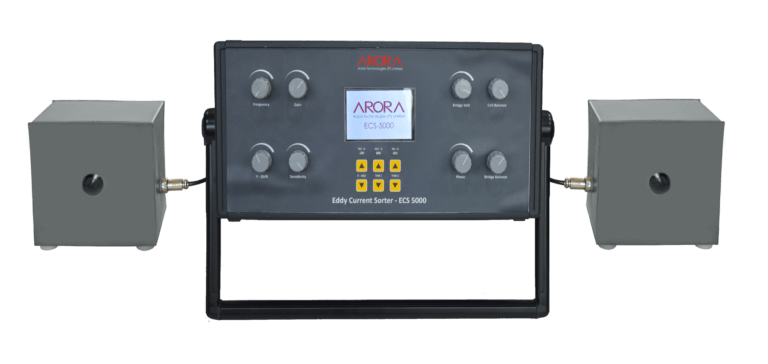
Eddy Current Sorter (ECS-5000)
The Eddy Current Sorter (ECS-5000) is an advanced metal sorting unit that is capable of separating non-ferrous metals such as aluminium, copper, brass, alloy from dry recyclables. In all industries mix-up of metals in the form of raw, semi-finished or finished products may occur in transit, storage or at different stages at manufacturing processes and is segregated by chemical, Spectro analysis or metallurgical tests. When proper coils are selected, Eddy Current Sorter is used for segregation of ferrous and non-ferrous metals without even a scratch on job or when bulk materials having external similarity are mixed up. Eddy Current Sorter can segregate metals of all forms and conditions when proper coils are selected. This instrument is widely used for segregation of mixed-up of metals in the form of bars, pipes, tubes, rods, bolts, nuts, gears, machined components, forged parts, and various types of metal components in automobile industries, heat treatment shop, fastener industries, forging unit, metal processing unit, fertilizer, refinery, and petrochemical projects & also final inspection in quality control department.
Eddy Current Sorter ECS 5000 is sturdy, light weight and portable test unit with an adjustable handle. Powered from single phase, 230V AC, 50 Hz source. The unit offers sine wave display. A nine (9) position rotary band switch (frequency from 10 Hz to 5000 Hz), two threshold level controls to set upper and lower limits of acceptance, a phase control to adjust the 10° to 170° phase of the sine wave. Three level indicators (Red for upper rejection, Green for acceptance and Blue for lower rejection) to indicate three different groups according to limits of acceptance set, buzzer is provided at rejection mode to alert the operator.

Kit Contains:
- Eddy Current Sorter ECS-5000
- 1 Pair of Coils
- Operation Manual
- Certificate of Conformance
FAQs
1. What is Eddy current sorter?
Ans: It is an electromagnetic equipment used in various industries to sort the material mix up. The non-ferrous conductive materials are conveniently separated using this equipment at very faster rate.
2. How ECS-5000 works?
Ans: The two encircling coils of the ECS produces eddy currents on test material surface, any variation in conductive properties of any of the material will change that generation of eddy current, that variation is picked by internal circuit of the equipment and signal is indicated on the screen. If the signal crosses the rejection limits, alarm is given by the equipment. So that part is separated from the acceptable material.
3. Can ECS-5000 sort different steel grades?
Ans: ECS-5000 is designed to sort ferromagnetic material based on grade, chemical composition, permeability variation and hardness.
4. What is the frequency range of ECS-5000?
Ans: ECS-5000 has 9 discrete frequencies from 10Hz-5KHz. [10,20,50,100,200,500,1000,2000,5000] Hz.
5. Can I use it for irregular shaped components?
Ans: If part is irregular in any one plane the coil can be designed as per the parts geometry using which it is possible to test irregular shaped parts. Part dimensions and shape is needed to design the coil.
6. Is single coil pair suitable for different sized parts?
Ans: Excessive clearance between the test part and coil makes testing inefficient, the fill factor of 0.90 is required for accurate results. So, the coil size shall be selected to meet the above requirement. [The ratio of cross sectional area of test part to cross sectional area of the coil is called fill factor].
7. How sensitive the system is?
Ans: The system can detect conductivity or hardness variation of ±5% after equipment calibration.
8. What is the power supply required for ECS-5000?
Ans: ECS-5000 is single phase 230V 50Hz 5Amp equipment with power consumption of 40Watts.
9. How to improve the signal response ?
Ans: Appropriate frequency selection, fill factor , uniform testing speed helps to improve the signal response.
10. What is the test report format ?
Ans: ECS-5000 has real time display which do not store any data. No report is generated at the end of the test.




